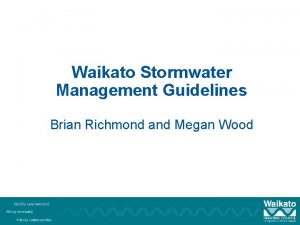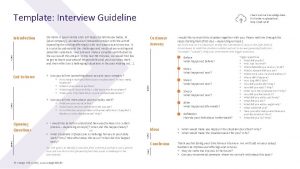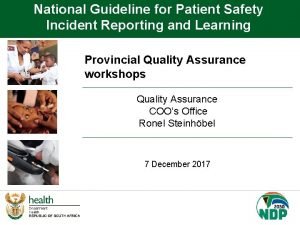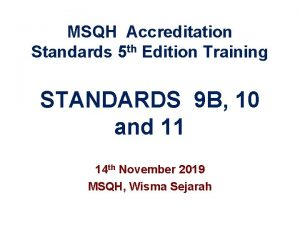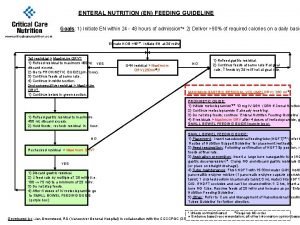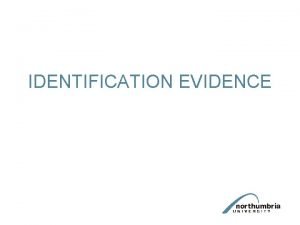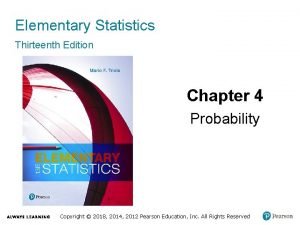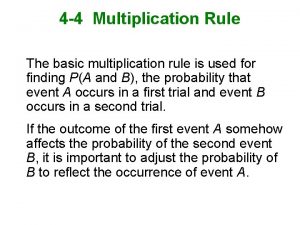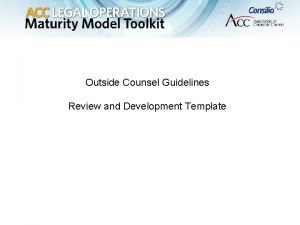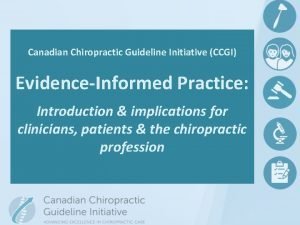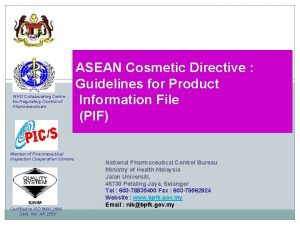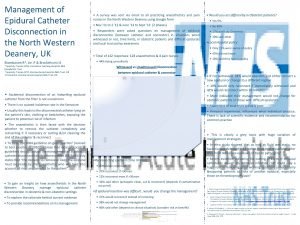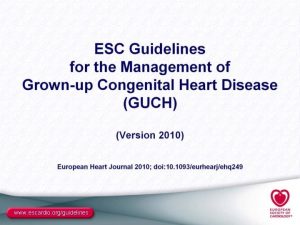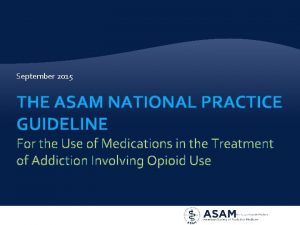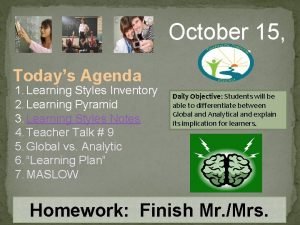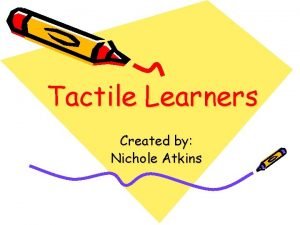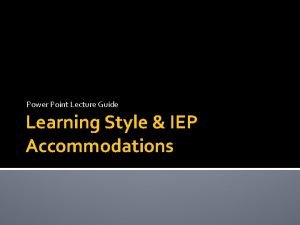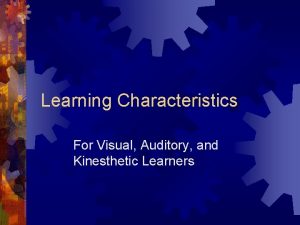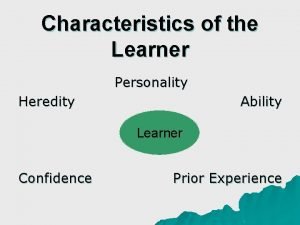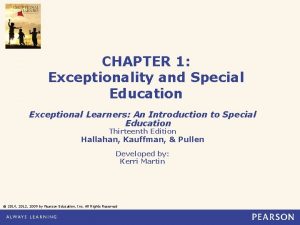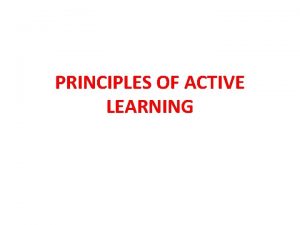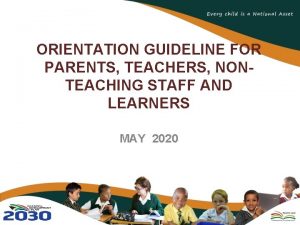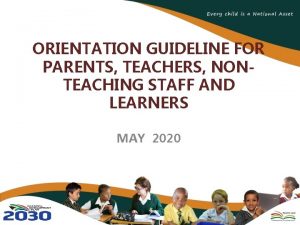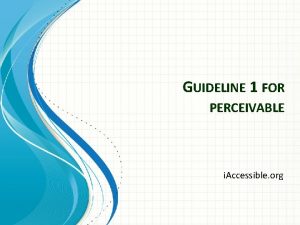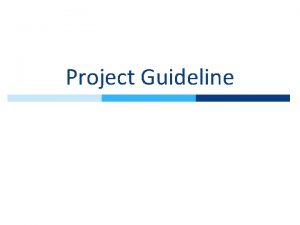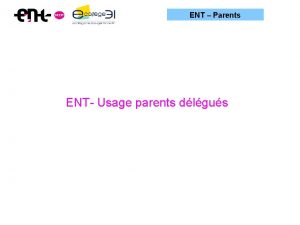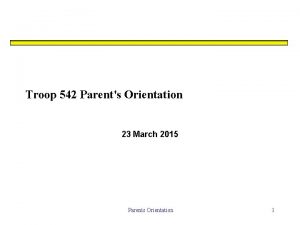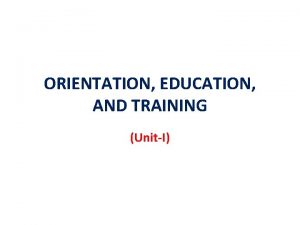ORIENTATION GUIDELINE FOR PARENTS AND LEARNERS MAY 2020

















































- Slides: 49

ORIENTATION GUIDELINE FOR PARENTS, AND LEARNERS MAY 2020

PRESENTATION OUTLINE 1. Background and Introduction 2. Purpose of the guidelines 3. Lockdown Regulations 4. Facts about COVID-19 5. Reduce stigmatization 6. How to take care of myself and my family 7. Taking care of your child's physical health 8. Structure a routine with your child 2

PRESENTATION OUTLINE 8. Learning time at Home 9. How can parents assist? 10. All learning should be active 11. Procedures to Follow when you are sick 12. Readiness for school 13. Support Contacts & Information 2

BACKGROUND & INTRODUCTION

BACKGROUND 31 December 2019 WHO China Country Office cluster of pneumonia cases in Wuhan City, Hubei Province (China) 07 January 2020, the causative pathogen was identified as a novel coronavirus (2019 -n. Co. V) 05 March 2020 first COVID-19 Case confirmed in RSA 16 March 11 March 2020 State 2020 of Disaster Pandemic declared by President the WHO Ramaphosa 18 March 2020 Minister of Basic Education announced the closure of schools

INTRODUCTION • • Countries across the world including South Africa, have taken drastic measures to curb the spread of the virus and reduce the extent to which infections are increasing. Some of these measures included: – promotion of healthy hygienic practices; – social distancing (e. g. prohibiting gatherings in every sphere of the life of people that are more than 100 in number); – closing of boarders and prohibiting non-citizens to enter the country; – screening and testing of citizens coming back home from other parts of the world; – promoting self-isolation and quarantining of those who present with symptoms. President Cyril Ramaphosa announced on 23 April 2020 the easing of lockdown restrictions form 01 May 2020. To balance the need for resuming economic activity with the imperative to contain the virus and save lives, the President announced a new approach where the measures being implemented are determined by the direction the pandemic is taking in the country (see summary of alert levels).

SUMMARY OF ALERT LEVELS ALERT LEVEL 5 ALERT LEVEL 4 ALERT LEVEL 3 ALERT LEVEL 2 ALERT LEVEL 1 OBJECTIVE Drastic Extreme Restrictions on Physical Most normal measures to precautions to many distancing and activity can contain the limit activities, restrictions on resume, with spread of the community including at leisure and precautions virus and save transmission workplaces social activities and health lives. and outbreaks, and socially, to to prevent a guidelines (Full while allowing address a high resurgence of followed at all lockdown) some activity risk of the virus times. to resume transmission Population prepared for an increase in alert levels if necessary

PURPOSE OF THE GUIDELINE

PURPOSE OF THE ORIENTATION GUIDELINE To provide information on COVID-19 and: This guide is for all learners parents, guardians, administrators and all stakeholders in the education system. The Gauteng Department of Education recognises the need to help parents and guardians get through this lockdown period as effectively as possible. These guidelines are designed to provide advice and strategies to help parents support their children at this time.

Why the guidelines • This guidance provides key messages and considerations for engaging parents, caregivers guardians and community members, as well as children themselves in promoting safe and healthy environments.

FACTS ABOUT COVID

Explanantion of the virus? • COVID-19 is spread by fluid droplets when coughing, sneezing or shouting and can be spread by a person who has been infected before symptoms occur, during illness and for a short period of time after they feel better • Researchers estimate that around 44% of infections are passed on by people who are not showing any symptoms • Virus particles can survive in the air for a short period of time and can remain on hard surfaces such as plastic or steel for a few days, if not removed with regular cleaning • COVID-19 is spread by contaminated hands touching the hands of others and touching things such as money, books, stationery, door handles and counters • When you then touch your eyes, nose and mouth after you have touched other people’s hands and things with COVID-19 on it, then you can get infected • Because Coronavirus is a new virus, there is currently no vaccine available. However, many of the symptoms can be treated

SYMPTOMS

WHAT IS COVID-19? On 31 December 2019, the World Health Organization (WHO) China country office reported a cluster of pneumonia cases in Wuhan City, Hubei Province of China. Severe acute respiratory syndrome associated with a novel coronavirus were confirmed. The virus has been named “SARS-Co. V-2” and the disease caused “coronavirus disease 2019”, or COVID-19

OVERVIEW OF THE LOCKDOWN REGULATIONS AND GUIDLINES • • • Because this is a new virus, doctors and scientists need some time to learn about it, so that they can develop a vaccination and better treatments. To give the doctors and scientists time to learn about the virus, we all need to stay home for a while. This lockdown period also gives our government time to prepare our public health system – to train hospital staff and put proper systems in place, to buy enough equipment for all hospitals, and to hire as many hospital staff as possible. Once the spread of the virus is under control, and our hospitals are ready to care for many sick people, the lockdown may slowly be lifted. People will start going back to work and school in a staggered manner – not all at once. Many of us will still have to be tested, and there will still be many rules to follow to ensure that the virus stays controlled.

Reduce Stigmatization The level of stigma associated with COVID-19 is based on three main factors: 1) it is a disease that’s new and for which there are still many unknowns; 2) we are often afraid of the unknown; and 3) it is easy to associate that fear with ‘others’. It is understandable that there is confusion, anxiety, and fear among the public. Unfortunately, these factors are also fueling harmful stereotypes.

REDUCE STIGMATIZATION • Rumours and fake news are also viral "Social media has not only propagated doubtful rumours on the emergence of the virus, but also has brought forth absurd methods for prevention. • It must be noted that not only infectious diseases like Corona are linked to discrimination and prejudice. • For many patients with genetic and chronic disease, being labelled, stereotyped and separated has become daily routine. "

WHAT IS THE IMPACT? • Stigma can undermine social cohesion and prompt possible social isolation of groups, which might contribute to a situation where the virus is more, not less, likely to spread. • This can result in more severe health problems and difficulties controlling a disease outbreak.

WHAT IS THE IMPACT? • Stigma can: • • Drive people to hide the illness to avoid discrimination • • Prevent people from seeking health care immediately • • Discourage them from adopting healthy behaviours • Fight the virus, not the people ”Together, we can. Together, we unite!” Robby, 24, Indonesia (Follow him on Instagram)

REDUCE STIGMATIZATION… • Rumours and fake news are also viral "Social media has not only propagated doubtful rumours on the emergence of the virus, but also has brought forth absurd methods for prevention. • It must be noted that not only infectious diseases like Corona are linked to discrimination and prejudice. • For many patients with genetic and chronic disease, being labelled, stereotyped and separated has become daily routine. "

HOW TO TAKE CARE OF MY FAMILY

WHAT CAN PARENTS DO? • Generally, your children will cope as well as you do. • If you want your children to be calm and coping, then you have to try to be calm and coping. • Children of all ages will react to your actions and attitudes, not just to what you say. • Because of this, you need to find some private time and space to talk to other adults about your own fears, worries and stress. Do not let your children hear these discussions. • If you do not have anyone to talk to, reach out to one of the many helplines available. • You must try to regulate your own moods and anxieties, in order to present the best model possible for your children. • Your children must feel that you are in control and making the best decisions possible for their well-being.

Take Care of your Children's Mental Health & Well-being • Start by asking your children what they know about the virus and the lockdown, and how they feel about these events. • Show your children that you are giving them a safe space to openly and honestly share their thoughts. • Listen attentively as they speak. • Do not interrupt, do not correct what they are saying, do not laugh at or ridicule your children, and do not cut them off. • If children answer your questions with short or one-word answers, gently ask some probing questions, to encourage them to talk more. For example: ‘What do you mean by that? ’ or ‘Can you tell me more about…’

Take Care of your Children's Mental Health & Well-being… • Be patient. Many children will ‘blame’ their parents, and direct their frustration, anger, disappointment and boredom towards you. • As your children speak, make mental notes of their misconceptions about the situation and of their emotional states. • Give children accurate, age-appropriate information to correct misconceptions, reduce anxiety, and to give them hope. • Keep the information that you share simple but accurate. • Share this information in a calm, clear manner. • Do not make promises that you cannot keep, • However, you can give them reassurances that you will try your very best to stay safe, and to keep your children safe. • Give your children hope. • Try to clear up any misconceptions or misunderstandings that your children may have about the virus or about the lockdown.

SIGNS TO LOOK OUT FOR • • • Feeling sad or crying when there is no apparent reason Anger and frustration when there is no apparent reason Not taking part in activities they would usually enjoy at home Loss of interest in spending time with family or friends via social media Arguing or fighting with family or friends on social media • Tiredness and loss of energy Sleeping too much or struggling to sleep Changes in appetite Angry outbursts, disruptive or risky behaviour Self-harm (e. g. cutting, burning, or otherwise hurting themselves)

HOW TO DEAL WITH YOUR CHILDREN IF THEY NOT COPING • Talk to your children about aggressive or negative behaviour that you would like changed and give them clear alternatives for what you would like them to do instead. • When their behaviour changes for the better, give them positive feedback about what you see (e. g. When you spoke calmly to me, I really appreciated it). • Give your children a lot of love. Tell them that you love them. Listen to them when they talk to you. If you are in lockdown together, give them hugs and show physical affection. • Give your children hope – talk about life after lockdown. Talk about seeing their friends again, about going back to school, about playing outside, and about their plans and dreams for the future. • If the situation does not improve or even gets worse, reach out to one of the many helplines available.

PHYSICAL HEALTH

WHAT CAN PARENTS DO? Teach your children to use the five golden rules to stay safe from COVID-19. • Wash your hands with soap and water whenever you can. Rub your hands with the soap for twenty seconds. Wash your thumbs, the backs of your hands, and between your fingers. • Try not to touch your faces. Viruses usually get into our bodies through our mouths and noses, so we must try our best not to touch them. • Sneeze or cough into your elbows or into a tissue. If you use a tissue, throw it away. • When you have to go out, stand at least 1. 5 metres away from other people. Do not hug, • Hold hands or touch other people. If you can, wear a mask when you go out. • If you feel sick with a temperature, aches or a cough, you must tell an adult.

PREVENTATIVE MEASURES

STRUCTURE A ROUTINE

ROUTINE MAKE THEM FEEL SAFE • As parents and guardians, we need to build a sense of security and normalcy for our children as they wait to return to school. • We need to keep our children connected to their ‘normal lives’ by encouraging them to do as many of their regular activities as possible. • Work with your children to structure a routine that works for your family. • Sit down with some paper and a pen and hold a discussion with your children about routines. • Explain that routines will make life easier for everyone in the household, with fewer arguments and conflicts. • Also explain that lockdown is stressful for you as parents, and that having your children’s co-operation will support and help you enormously.

ROUTINE MAKE THEM FEEL SAFE… Talk about the kinds of activities that should be included in a daily routine. Encourage your children to suggest these activities. Remind your children that they will return to their ‘normal lives’ and they must not lose their knowledge and skills during this time. Explain that depending on the ages of your children, they may have different routines. Make sure that your children’s routines also work for you. Ensure that children do some of the chores that need to be done and that meals take place at times that suit the whole family.

LEARNING AT HOME

HOW CAN PARENTS ASSIST Make an appropriate space for your children to do their work and help them to organise their resources. Arrange a suitable workspace for your children to do their learning. This can be a space at a kitchen or dining table, or it can even be a space on the floor. Encourage your children to always work in the same space, as part of their routine. Encourage your children to get all of their schoolbooks out, and to make sure they are properly organised. Also collect all the stationery in the house and from your children’s school bags. Try to ensure that they have access to pens, pencils, and any other equipment that they may need. Finally, collect any reading resources that are available in your home. This includes textbooks, DBE Workbooks, reading books, magazines or pamphlets, novels, newspapers, the Bible, etc.

LEARNING SHOULD BE ACTIVE • • • • Do not assume that your children are necessarily learning if they are watching an educational programme – they could easily be daydreaming! It is important to help your children to use technology effectively for the purposes of learning. What can parents do about this? Take advantage of TV, Radio or Online Learning Programmes that you can access. In particular, encourage your Grade 10 -12 children to watch TV programmes that teach Mathematics, Science or Language skills and Concepts. Also look for any digital reading resources that you can download for your children to read on a smartphone, tablet or computer. Note that ‘zero-rated’ websites are free – accessing these websites does not require any data. Help your children select programmes that are relevant and build these into their routines. Look through programme guides together to select programmes that are relevant. Do this in advance – look through the programme schedules at the start of the week. Build these activities into your children’s routines as part of their ‘learning time’. Ensure that there is a balance to your children’s learning activities – they should not spend all their time watching TV or on a smart phone.

LEARNING SHOULD BE ACTIVE… • • • • Before the start of the programme, ensure that your children have the correct textbooks and/or exercise books with them. They should also have a pen, pencil, ruler and any other any stationery that may be required. Help your children to put the lesson that they are going to experience into context. Do this by looking for the lesson topic in the textbook and going over the previous lesson. Check in on your children as they watch or listen to the programme. Encourage them to take notes during the programme, to remind them of what they have learnt. They should also write down any questions that they have. Hold a brief discussion about what has been learnt. At the end of the programme, check to see that your children have written some notes. Next, hold a brief discussion about the programme. You could ask questions like: Was that programme interesting? Why or why not? What did you learn from it? Is there anything you didn’t understand or are unsure of? Do you have any other questions about this topic? Have you read about this in your textbook?

WHAT TO DO WHEN SOMEONE IS SICK

WHAT TO DO IF I HAVE FLU LIKE SYMPTOMS? • The symptoms of COVID-19 include cough, sore throat, shortness of breath or fever. However, these are also symptoms of the flu. • The National Institute of Communicable Diseases (NICD) recommends that you should only get tested if you display symptoms plus: • Been in contact with a confirmed COVID-19 person; • Travelled to a high risk country; • Worked in or been to a healthcare facility treating people with Covid-19; Have a severe case of pneumonia with an unknown cause

WHERE SHOULD I GO? • If you think you might have contracted the virus, you can call the NICD helpline (0800 029 999) and you will be advised on possible testing facilities or local clinics

IF I TEST POSITIVE • Anyone who is sick or displaying symptoms should not go to school or work. • If you have been in close contact with a confirmed COVID-19 case, you should selfisolate for 14 days from the date of close contact. • If you are concerned, contact your medical practitioner for further advice.

HOW IS COVID-19 TREATED? • There is no specific treatment available for SARS-Co. V-2. • Treatment is supportive (e. g. providing oxygen for patients with shortness of breath or managing a fever). • Antibiotics do not treat viral infections. However, antibiotics may be required if a secondary bacterial infection develops. Currently there is a vaccine being developed.

PREPARATION FOR SCHOOL

HOW DO I PREPARE MY CHILD FOR SCHOOL? • • • Prepare your child mentally for school Communicate their uncertainties in a open and honest manner. Ensure for their well-being and explain that safety measures are put in place at the school. The school will follow a phased in approach which will start with Grade 12 and 7 and the other grades will be phased in. This will be communicated through the school and media. Ensure that the transport follows safety measures, which includes the number of passengers travelling and if the transport is sanitized. Prepare your child daily to follow precautions: wearing a mask daily and washing their hands with soap and water. It is important to practice social distancing and good hygiene to prevent becoming infected if one is walking to school. The school will communicate with the parents regularly on updates regarding COVID-19. The school will be sharing information daily with your child, to be well informed. If your child is unwell communicate with the school and keep the child home. Communicate with your school to seek clarity with any uncertainties or questions.

PSYCHOSOCIAL SUPPORT

SELF CARE TIPS • Avoid excessive exposure to COVID-19 media and social media coverage, especially negative ones, to avoid mental health effects • Maintain a healthy diet and positive lifestyle, and reach out to others for comfort and consolation that the situation will eventually be contained • Maintain a sense of positive thinking and hope • Take personal or group time to unwind and remind the self that the intense feelings of fear, panic, and anxiety will fade. Remember to practice social distancing when in groups

SIGNS THAT SOMEONE NEEDS HELP • Persistent fear, worry and anxiousness • Persistent sadness, hopeless and other overwhelming emotions • Withdrawal from others (the kind that is different from the social distancing prescribed by the Department of Health) • Loss of interest in personal appearance and unusual lack of energy • Expressing rage or anger at the world • Missing work or classes • Use of or increased use of drugs or alcohol

CONTACT NUMBERS • • • • Emergency Hotline: 0800 029 999 Whats. App Support Line: 0600 -123456 For Psychosocial Support Call: Gender Based Violence: 0800 428 Command Centre *120* 7867* Command Centre for deaf and disabled SMS "help" to 31531 South African Depression, Anxiety, Depression and Suicide (SADAG) 0800 456 789 Suicide Hotline: 0800 567 Childline 08000 55555 Teddy Bear Clinic 011 484 4554 CIPLA 24 hour Mental Health Hotline. Helpline for Anxiety, Depression & Suicide 0800 456 789 Whatsapp 076 882 2775

CONTACT NUMBERS • • • National Crisis Line- 24 hour service for all forms of abuse, HIV/AIDS, Suicide, bereavement, eating disorders and other problems 0861 322 South African Police Services 08600 10111 SADAG South African Depression and Anxiety Group - ADHD - Helpline 0800 55 44 33 Child Welfare South Africa - Report Child Abuse or neglect 0861 452 4110 Family and Marriage Association of South Africa (FAMSA) 011 975 7106/7 Food Parcels Services 011 241 8324 South African Social Security Agency (SASSA) 0800 601 011 or gautengenquiries@sassa, gov. za Gauteng Government Food Parcel Helpline 0800 428 8364 or support@gauteng. gov. za

 Frida kahlo tableau famille
Frida kahlo tableau famille Parents parents
Parents parents Frida kahlo histoire des arts
Frida kahlo histoire des arts Polycentric company
Polycentric company How to welcome parents in orientation
How to welcome parents in orientation Code of conduct for teachers 2019
Code of conduct for teachers 2019 Government program for gifted students in the philippines
Government program for gifted students in the philippines Passive learning vs active learning
Passive learning vs active learning Waikato stormwater management guideline
Waikato stormwater management guideline Interview guideline template
Interview guideline template Anemia in pregnancy guideline
Anemia in pregnancy guideline Guideline anamnesa
Guideline anamnesa National guideline for patient safety incident
National guideline for patient safety incident Msqh guideline
Msqh guideline Anamnesa psikologi
Anamnesa psikologi East practice management guidelines
East practice management guidelines Enteral feeding guideline
Enteral feeding guideline Haircuts that generally have less weight
Haircuts that generally have less weight What is a guideline for hoisting a hoseline?
What is a guideline for hoisting a hoseline? Turnbull guidelines uk
Turnbull guidelines uk 5% guideline for cumbersome calculations
5% guideline for cumbersome calculations Formal multiplication rule
Formal multiplication rule Who guideline on country pharmaceutical pricing policies
Who guideline on country pharmaceutical pricing policies Outside counsel guidelines
Outside counsel guidelines Canadian chiropractic guideline initiative
Canadian chiropractic guideline initiative Chronic pancreatitis guideline
Chronic pancreatitis guideline Bpfk cosmetic guideline
Bpfk cosmetic guideline Guideline clinical nutrition in patients with stroke
Guideline clinical nutrition in patients with stroke Disconnected epidural catheter guideline
Disconnected epidural catheter guideline Escardio guideline
Escardio guideline Asean stability guideline
Asean stability guideline Asam national practice guideline
Asam national practice guideline Srm process flow
Srm process flow Aki kdigo 2012
Aki kdigo 2012 Fmea guideline
Fmea guideline Cushing syndrome mnemonic
Cushing syndrome mnemonic Global vs analytical learners
Global vs analytical learners Teaching grammar to young learners
Teaching grammar to young learners Tactile learner definition
Tactile learner definition Definition of remedial teaching
Definition of remedial teaching Global vs analytical learners
Global vs analytical learners Characteristics of auditory learners
Characteristics of auditory learners Eager learning algorithm example
Eager learning algorithm example Kinesthetic learners definition
Kinesthetic learners definition When is cognitivism beneficial for learners
When is cognitivism beneficial for learners Domain 3 diversity of learners examples
Domain 3 diversity of learners examples Characteristic of learners
Characteristic of learners Exceptional learners: an introduction to special education
Exceptional learners: an introduction to special education Assistive technology for english language learners
Assistive technology for english language learners Active learning principles
Active learning principles








